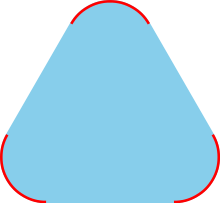Kerin-Milman's theorem
The theorem of Kerin-Milman (after Mark Grigorjewitsch Kerin and David Milman ) is a theorem from the mathematical branch of functional analysis .
statement
If a Hausdorff locally convex space and in it a non-empty , compact and convex subset , then has extremal points and is equal to the closed convex hull of the set of all these extremal points.
The proof of the Kerin-Milman theorem is based on Zorn's lemma (or an equivalent maximal principle of set theory) and Hahn-Banach's theorem and thus assumes the validity of the axiom of choice .
As Walter Rudin shows in his monograph Functional Analysis , the statement of the theorem also applies to the more general case of a Hausdorff locally convex space , whose dual space represents a point-separating set for the spatial points of . It is this more general version, which Rudin calls the theorem of Krein-Milman ( English Krein-Milman theorem ).
The Kerin-Milman theorem has a partial inversion, which is usually referred to as Milman's theorem : If is a compact, convex set and is such that is equal to the closed convex hull of , then in the topological closure of contain all extremal points of .
A tightening of the Kerin-Milman theorem is the Choquet theorem . Considerably longer applies in finite - dimensional and, in particular Euclidean spaces: Here are the Minkowski theorem and the theorem of Carathéodory still much sharper statements before.
The Straszewicz theorem and the Klee – Straszewicz theorem are closely related to the Kerin-Milman theorem , in which the set of exposed points takes the place of the set of extreme points.
application
The Banach space of real or complex zero sequences with the supremum norm is not a dual space .
If it were a dual space, the unit sphere would be compact in the weak - * - topology according to the Banach-Alaoglu theorem, i.e. it would have extremal points according to the above theorem of Kerin-Milman. But if there is any point from the unit sphere, then there is an index with , because the sequence converges to 0. If now is defined by for and , then is and and , that is, the arbitrarily given point is not an extremal point. So the unit sphere of has no extremal points and therefore cannot be a dual space.
See also
literature
- Harro Heuser: Functional Analysis , Theory and Application, Teubner, November 2006, 362–363.
- Jürg T. Marti: Convex Analysis (= textbooks and monographs from the field of exact sciences, mathematical series . Volume 54 ). Birkhäuser Verlag, Basel, Stuttgart 1977, ISBN 3-7643-0839-7 ( MR0511737 ).
- AP Robertson, WJ Robertson: Topological vector spaces . Translation from English by Horst S. Holdgrün (= BI university paperbacks . 164 / 164a). Bibliographisches Institut, Mannheim 1967, p. 147-149 ( MR0209926 ).
- Walter Rudin: Functional Analysis (= International Series in Pure and Applied Mathematics ). 2nd Edition. McGraw-Hill , Boston (et al.) 1991, ISBN 0-07-054236-8 , pp. 75-77 ( MR1157815 ).
- Dirk Werner : Functional Analysis (= Springer textbook ). 6th, corrected edition. Springer Verlag , Berlin, Heidelberg 2007, ISBN 978-3-540-72533-6 , pp. 418 ff .
Individual evidence
- ↑ M. Kerin, D. Milman (1940): " On extreme points of regular convex sets ", Studia Mathematica 9, 133-138.
- ↑ Dirk Werner: Functional Analysis. Springer Verlag, Berlin and Heidelberg 2007, p. 418 ff.
- ^ Walter Rudin: Functional Analysis. McGraw-Hill, Boston (et al.) 1991, p. 75 ff.
- ^ Walter Rudin: Functional Analysis. McGraw-Hill, Boston (et al.) 1991, p. 75
- ↑ This reverse sentence to Krein-Milman's is not identical with Milman-Pettis' theorem .
- ↑ Dirk Werner: Functional Analysis. Springer Verlag, Berlin and Heidelberg 2007, p. 423



















